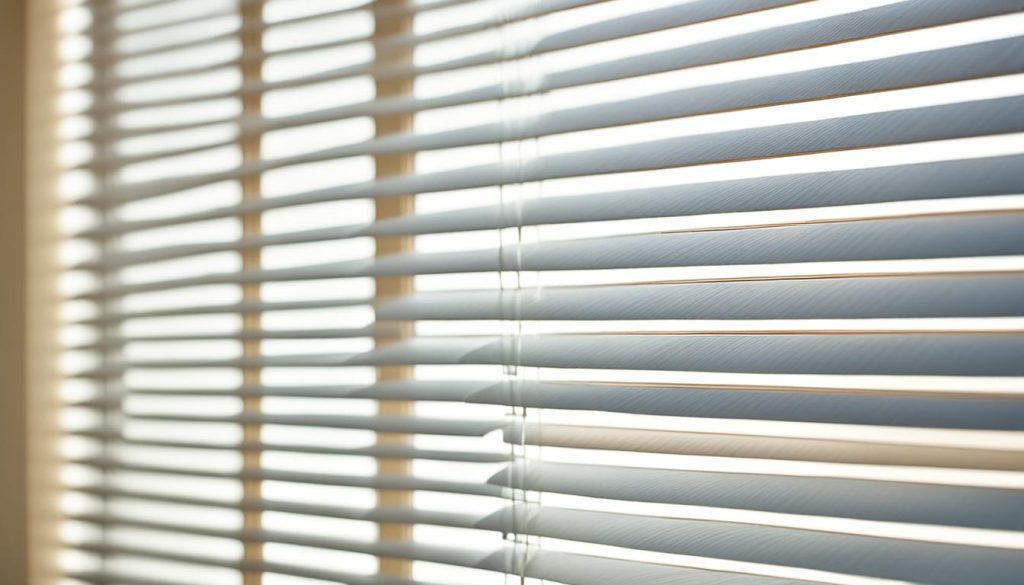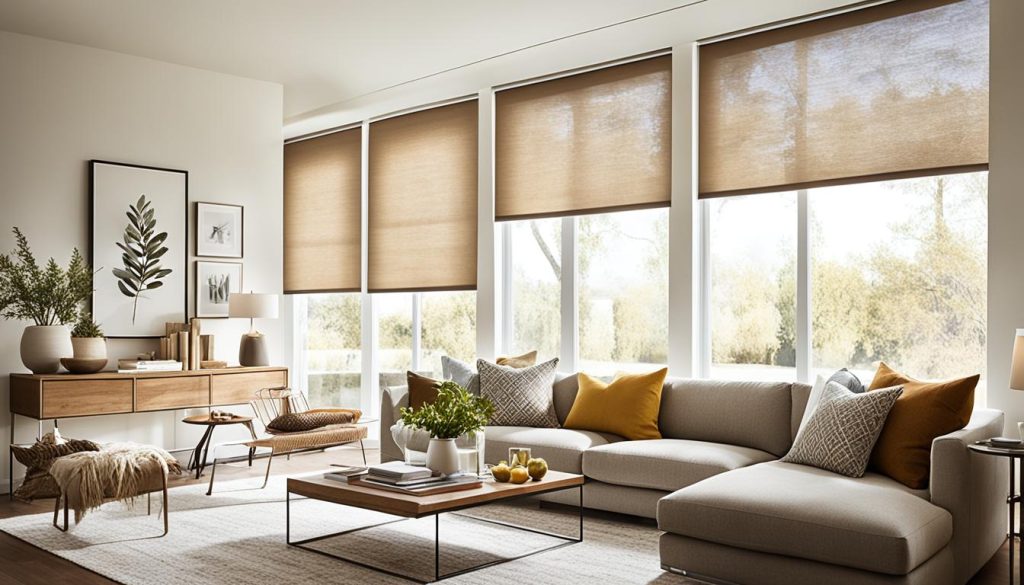Imagine waking up with clear sinuses. This might seem rare if you suffer from allergies. Window treatments play a big role in keeping your air clean, especially if you get sneezy from dust, pet fur, or pollen.
If you’re battling allergies, choosing the right curtains or blinds is about your health, not just looks. Going for hypoallergenic window treatments can change your life. Things like roller shades or wood shutters are easy to clean. This means less dust and happier sinuses.
On the other hand, certain curtains and blinds can make things worse. Avoid heavy drapes and mini blinds. They trap dust and make cleaning a pain. This means more sneezing and discomfort.
Choosing smart with your window treatments helps fight allergy symptoms. Look for options that keep the dust away. Yet, make sure they still fit your style and are easy to clean. This way, you create a home that feels good and looks great.
Understanding Allergens in Window Treatments
Keeping window treatments clean is key for those with allergies. Window coverings can trap dust, pollen, pet dander, and more. This makes air quality worse and can increase allergy symptoms. Knowing how to clean your window treatments is important for a healthier home.

Window treatments can add to dust in your home. The type of material can affect how much dust is collected. Natural fabrics like cotton and linen are better for people with allergies.
Certain curtains are made to fight allergens and are called hypoallergenic. Roller shades are great because they don’t gather dust easily. Roman shades and vertical blinds are also easy to keep dust-free.
Choosing natural materials for window treatments is good for the environment and your health. Adding HEPA filters can also improve air by catching most allergens and particles. This makes your home safer for those with allergies and helps the planet too.
To reduce allergens, pick window treatments that don’t collect much dust. Clean them regularly to make your home healthier and more comfortable for everyone.
Roller Shades: A Practical Choice for Allergy Sufferers
Roller shades are great for people with allergies because they gather less dust. Homes can get up to 40 pounds of dust a year. So, choosing the right window coverings is key. Roller shades are easy to clean thanks to their flat surface. This makes them a top pick for reducing dust and allergens at home. They’re better than fabric coverings which can hold onto dust mites.

Roller shades help keep your home clean by stopping dust from settling when they’re up. They not just block light but also keep pollen out, which is great during allergy seasons. Because of this, roller shades really do help you have fewer allergies in your home, making the air cleaner.
Maintaining roller shades is simple. You can wipe them down or use a vacuum with a HEPA filter. This traps almost all the dust and allergens. They’re known for keeping homes cleaner and being easy for allergy sufferers to take care of. That’s why many recommend roller shades for anyone wanting cleaner air and less allergens indoors.
Vertical Blinds and Their Benefits for Reducing Dust
Vertical blinds stand out as the best choice for keeping dust away. They prevent dust from gathering on surfaces, making the air cleaner at home. Since homes get about 40 pounds of dust every year, vertical blinds help keep things tidier.
Vertical blinds made from PVC or vinyl resist dust well. They are simple to clean, which makes them great for homes wanting fewer allergens. You can quickly clean the slats with a wet cloth or duster, keeping dust and allergy-causing particles away.
Vertical blinds are also good for preventing sinus problems that fabrics and synthetics can cause. They make living spaces healthier. Whether you choose faux wood or PVC, they are excellent for anyone wanting to control allergens.
Hypoallergenic Curtain Options to Consider
Choosing the right material for hypoallergenic curtains is key for allergy sufferers. Natural fabric curtains, like cotton, linen, or silk, are top choices. They’re less likely to attract dust mites and other allergens. This makes them ideal for people who need hypoallergenic window treatments.
For those with allergies, it’s crucial to select window treatments that resist allergens. Curtains with closely woven fabric are better since they don’t trap dust and particles easily. Plus, it’s important to regularly clean your curtains to reduce allergens. Choosing machine-washable curtains makes this task simpler and helps keep your home allergy-free.
Proper care for hypoallergenic curtains means selecting the correct fabric and regular cleaning. It’s vital to clean them often, either by machine washing or gentle hand washing, to cut down on dust. This way, you can improve the air inside your home and lessen allergy symptoms.
Wide-Slat Blinds and Their Allergy-Preventative Mechanism
Wide-slat blinds are great for reducing allergies. Their bigger slats mean less dust collects on them. Not only do they look good, but they also help keep your home dust-free. Whether they’re made of wood, veneer, or plastic, they fit nicely with a minimal look. They work well in many types of rooms.
Wide-slat blinds are better than curtains at keeping dust away. Curtains catch dust in their folds. Wide-slat blinds are easy to clean with just a damp cloth. This makes them perfect for people with allergies. They help your home stay clean and free from dust mites and pet hair.
Wide-slat blinds also control the sun and heat in a room. By tilting the slats, you can reduce glare but still enjoy daylight. This makes your home comfortable and keeps the air clean. Wide-slat blinds are a smart choice for both style and health.
Maintaining and Cleaning Window Treatments to Minimize Allergens
Keeping your window treatment clean is key to cutting down allergens in your space. Homes get about 40 pounds of dust each year. That’s why it’s vital to frequently clean blinds and shades. Opt for materials like wide-slat blinds and shutters to keep dust at bay. These are top picks for allergen minimization.
Take vertical blinds as an example. They’re known for being good against allergens. This is thanks to their wide slats that you can wipe clean. Roller shades are also great for easy upkeep. Their surface stops dust from settling when you roll them up. For Roman shades with lots of details, a regular vacuum does wonders for the dust in their folds.
To lower allergens further, how you clean matters too. A vacuum with HEPA filtration grabs almost all dust and allergens. HEPA filter air purifiers also aid in keeping the air clean by cutting down on airborne particles.
But for blinds and shades of fabric or those with a cellular design, you might need to put in more effort. Although cellular blinds lower dust buildup, dust can get trapped in their honeycomb shapes. This means more frequent cleaning. Faux wood blinds are a smarter choice because they draw in fewer dust mites than fabric ones do.
Also, it’s smart to skip extra decorations like tassels that can gather dust. By choosing the right cleaning methods and maintenance, you make your home more allergen-free. This makes for a healthier, more comfortable living space.
Innovative Allergy-Reducing Window Solutions
Today’s blinds and shades are far more advanced, designed with allergy sufferers in mind. Cellular shades stand out by trapping dust and allergens. This stops them from floating around the room. They also make air cleaner and help your air conditioning work better. Also, composite shutters like plantation shutters have angled louvers. These louvers block allergens and are easier to clean than fabric curtains.
Roller shades are great for reducing allergies too. They have a smooth, non-porous surface that doesn’t hold dust or pollen. Each time you roll them up or down, you’re also helping shake off allergens. Waterproof vertical blinds made of PVC or vinyl are also good. They’re easy to clean with just a duster or a microfiber cloth. This helps keep the air clean and stops dust from building up.
To really fight allergies, think about putting air purifiers by your windows. They catch contaminants well. Since dust mites love windowsills and curtains, choose easy-to-clean options. Go for composite shutters, roller shades, or vertical blinds instead of fabric drapes. Choose ones you can wash in a machine, not those needing dry-cleaning. This cuts down on allergens. Adding a screen pollen filter is smart too. It can stop about 96% of pollen from getting inside. With these smart window treatments and extra steps, managing allergies gets easier.






